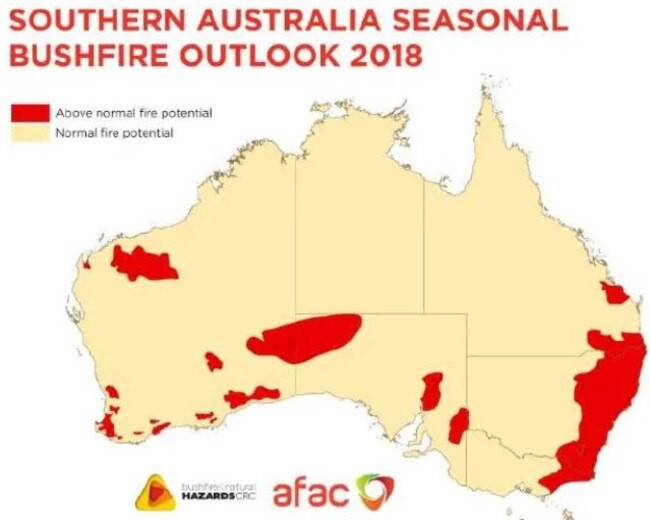Fifth State of the Climate report warns of extreme fire weather
Australia is experiencing the grim reality of global warming, including more extreme fire weather, as shown in the fifth State of the Climate report released today, Clare Peddie writes.
SA News
Don't miss out on the headlines from SA News. Followed categories will be added to My News.
- Martin Haese heads Premier’s Climate Change Council
- Bushfire season 2018/2019: Report warns of long fires
Fire-fighting in a warming world takes on a new and terrifying extra dimension, as energy released changes the atmosphere so that fires behave in different and unexpected ways.
Adelaide-based Bureau of Meteorology research scientist Dr Mika Peace is developing an international reputation for predicting fire behaviour in real-time, using combined fire and atmosphere models.
Her expertise was called for in the recent unprecedented Queensland bushfires, where she was able to provide much better information on how the fires were likely to behave, where resources were needed most and where evacuation was necessary, even where new fires were likely to start.

“It’s really satisfying and positive to see the research in action and to see how we can translate research, which has obviously had significant investment behind it, into supporting decisions in real-time and supporting the best decisions being made with the best information possible,” Dr Peace said.
“So it’s really great to see the science having an impact.”
She received special thanks from Queensland Premier Annastacia Palaszczuk last week.
Dr Peace is on standby this bushfire season for fire and emergency services across Australia, where it’s clear “we’re getting more frequent and larger fires”.
“Fire managers, the people out there on the ground, say ‘We just don’t understand why that fire behaved the way it did’. But if you just look at what’s happening at the surface, at the winds and the temperature, it doesn’t tell you the whole story,” Dr Peace said.
“The fire is getting some of its energy from above the surface, so what we’ve really been doing over the last few years is trying to understand how those processes work and how they manifest in terms of fire behaviour.”

There has been an increase in extreme fire weather, and in the length of the fire season, across large parts of Australia since the 1950s.
Fire weather is monitored using the forest Fire Danger Index, combining temperature, rainfall, humidity and wind speed to give an overall figure.
The Bureau of Meteorology shows fire weather conditions have become more common between 1978 and 2017.
The “heat map” is one of many startling figures in the State of the Climate 2018 report released today.
Bureau climate monitoring manager Dr Karl Braganza said the fire weather situation was an example of what’s called compound events, “influences from multiple changes in the climate system that culminate or coincide together”.
“Often the worst fire weather occurs when you’ve had long-term drought, long-term above average temperatures, maybe a short-term heatwave and then the meteorology consistent with fire weather, or the ability of a fire to spread,” he told a national media briefing.
“It’s those kinds of compound events that are going to be most challenging going forward in terms of adapting to climate change in Australia.”

The report also describes a trend in some regions towards an increasing number of days when high fire-danger ratings are combined with conditions that allow bushfires to generate thunderstorms.
“This can lead to extremely dangerous fire conditions as observed for the Canberra (2003) and Black Saturday (2009) fires, including generating additional fires from lightning strikes,” the report states.
The report, released every two years, draws on the latest climate monitoring, science and projections to describe changes and long-term trends in Australia’s climate.
It shows Australia’s climate has warmed by just over 1C since 1910 and the warming trend is likely to continue for decades to come.
More frequent and intense heatwaves on land are matched in the oceans, with marine heatwaves causing coral bleaching and southward movement of marine life as well as sea level rises.
The oceans have absorbed more carbon dioxide from the atmosphere, becoming more acidic, with consequences for corals and shellfish.
April to October rainfall and streamflow has decreased across southern Australia.
Global carbon dioxide has increased to levels not seen in at least 800,000 years.
The “unprecedented rate of change in the last hundred years” has been studied at CSIRO, using analysis of gas trapped in ice cores combined with air sampling at Cape Grim observatory, as CSIRO Climate Science Centre director Dr Helen Cleugh explains.
“We’ve been observing greenhouse gas concentrations at our observatory on the northwestern tip of Tasmania since 1976,” she said.
“That’s 42 years of hourly CO2 concentrations showing that in 2016 we breached the 400 parts per million milestone and we have consistently stayed above those levels since then.
“We know from our analysis of that air that the cause of the increase in CO2 activity is human activities, through burning fossil fuels and land use change.”
Together, the Bureau and the CSIRO have made it clear humans are responsible for the changes we’re experiencing and the warming trend will continue unless we address the greenhouse gas emissions.



